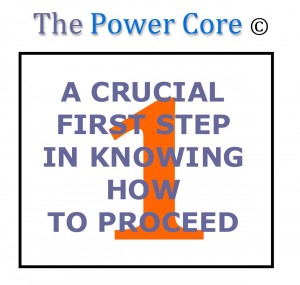The Chief Customer Officer (CCO) job is as much about knowing what motivates people as it is about getting the job done. I find that the keys to motivation lie in understanding the company Power Core.
Understanding the strength and pull of the Power Core uncovers the hot spots and potholes for driving a customer profitability culture. It frames the scope of work required to influence change. It provides clarity on the approach to take in creating partnerships with leaders and in motivating people within the organization through the change process. And it zeroes in on the corporate machine’s motivation and ability to drive movement toward customer profitability.
Most companies have a predominant Power Core. It is the place of strength from which the business emanates. Frequently it is the strongest skill set in the company, or the most comfortable to senior executives. Because executives know the Power Core best, people gravitate to perform in that area. Success in the power core area is assuredly met with acknowledgement and reward. The Power Core can be the most influential in directing the silos, and is one of the biggest determinants of how success, metrics, recognition, and company growth are defined inside the corporate machine.
Throughout all my years of driving change I’ve found that the complexity and scale of work required to drive customer profitability and loyalty into the business model is greatly impacted by the strength of the Power Core and its distance from the customer.

THE ELEPHANT IN THE ROOM
The interesting thing about the Power Core is that it is an unusually strong, yet often unspoken force. But don’t under estimate the power of its pull. Because executives make decisions through the filter of the Power Core, people will want to perform there…they will gravitate to perform where the enthusiasm is the highest, the understanding is the easiest, and the rewards are the greatest.
As a soldier inside the corporate machine, which would you choose? Would you focus on something people talk about in high level terms but which has no day-to-day accountability or compensation tied to it (a.k.a. “the customer thing”)? Or would you excel at your quarterly sales goals, which you receive urgent email messages on, receive quarterly spiffs for meeting target, and have posted stack-rankings which compare you to your peers?
The end game is to incorporate the drive for managing customer profitability into the Power Core. Because these goals and actions remain elusive, they’re simply not called for with the same level of gusto. In many cases, they’re not called for at all. Especially where there’s success at “pumping out sales,” saturating the marketplace and growth, or where the product demands continued updates and “captive customer loyalty,” it is difficult to take the time out to do what people consider the slow work of process, connecting the efforts across the organization and even counting the number and value of customers that go in and out your doors. The customer stuff always seems to be something to layer on top of the real work, rather than being part of the work itself. It’s often seen as the competition.
SIX PREDOMINANT POWER CORES. IDENTIFY YOURS.
There are six common Power Cores, which consistently have a say in how things go inside the corporate machine. You’ll likely find one of them to be the dominant factor in decision-making and direction in your company. You may also see another in a supporting second place of strength. Here are the six Power Cores which I’ve found to have the greatest impact on driving customer profitability inside the corporate machine:
The Six Predominant Power Cores
|
Product Power Core Product development is the focus. The product is the company in the marketplace and in the boardroom. Metrics are about new products, size of products, getting products out and speed of product development and competitive progress of products in relation to competitors. |
Marketing Power Core
Marketing defines the tenor and tone of the relationship with customers. Customer relationship may be collapsed to marketing campaigns and tactics. Brand at the advertising messaging level is emphasized, but the implications for how to tie that to the experience can fall short. |
Sales Power Core Motivation is toward making the numbers and performance is measured in short term sales goals and targets. Sales targets are the strongest and most tracked corporate metrics. Frequently the organization hasn’t worked together to ensure that the “after the sale” experience delivers on the promise of the sale. |
|
Vertical Business Power Core
A business discipline is the specialty and forms the core of power. For example; the business focuses strongly to be proficient in the discipline of insurance. The metrics revolve on the execution of an industry, frequently “as it’s always been done.” Processes can be inward focused rather than customer delivery focused. |
Technology Power Core As the bulk of spending related to IT projects far exceeds other financial requirements, IT has been given power in determining the priorities of the organization. Not just in computer resources, but by having a large say in representing, selecting and enabling IT dependent projects across the organization.
|
Customer Power Core Company decisions emanate from understanding what will drive greatest value to customers in the short and long term. Driving profitable customers aligns marketing, sales, product development; service, IT and operations investment. They connect to enable optimum product and sales execution to ensure optimum customer value is delivered. |
IDENTIFY YOUR COMPANY POWER CORE
Determining three dimensions of your business will do the job to define the Power Core and give you the sense you need to understand the scale and complexity of the job ahead:
- How does the company define itself?
- What metrics are called for the most?
- What successes are people rewarded for?
- What competencies are stressed? Which are considered “optional” or up to the individual zealots to nurture and push in the organization?




